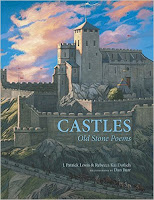Book Summary
 In this graphic novel, Emily and Navin move with their mother to the secluded home of her great-grandfather after witnessing the tragic death of their father. Warned that the house is haunted, they all soon find out that it really is. Emily discovers the amulet when searching through her great-grandfather’s things and puts it on. It seems to be talking to her when loud thumps are heard coming from the basement. The amulet warns Emily to keep the family together, but her mother insists upon going into the basement alone. There she is captured by a huge tick-like monster/robot. The kids run after her, following directions from the amulet, and are led to their great-grandfather. He dies as Emily agrees to become the amulet’s owner, or the stone keeper. Together with their great-grandfathers robots, they rush to save their mother. After almost saving her, they retreat…until the next book.
In this graphic novel, Emily and Navin move with their mother to the secluded home of her great-grandfather after witnessing the tragic death of their father. Warned that the house is haunted, they all soon find out that it really is. Emily discovers the amulet when searching through her great-grandfather’s things and puts it on. It seems to be talking to her when loud thumps are heard coming from the basement. The amulet warns Emily to keep the family together, but her mother insists upon going into the basement alone. There she is captured by a huge tick-like monster/robot. The kids run after her, following directions from the amulet, and are led to their great-grandfather. He dies as Emily agrees to become the amulet’s owner, or the stone keeper. Together with their great-grandfathers robots, they rush to save their mother. After almost saving her, they retreat…until the next book.
APA Reference of Book
Kibuishi, K. (2008). Amulet: Book one the stonekeeper. New York, NY: Scholastic.
Impressions
This graphic novel will appeal to readers at any level, but will be especially of benefit to reluctant readers. It reads more like a movie because of the full-color images that accompany the print, telling full as much of the story as the print. Ghosts never mentioned in the text appear lurking over shoulders, telling the reader far more than the characters understand. The mood created by events in the story is bleak; the reader isn’t quite sure if the characters will make it out alive. The characters are two-dimensional, but it doesn’t detract from the story, which is full of exciting and scary twists and turns. Some caution is advised because the children witness the death of their father.
Professional Review
This fantasy graphic novel will appeal to those reluctant readers with its interesting monsters and adventures. The dark pictures aid in portraying the dark shadow of the story and help set the mood. The prolog of the story relays the car accident and tragic loss of the children’s father and may be traumatic for some readers.
Thomas, K. (2008, February). Amulet book 1: The stonekeeper. [Review of the book
Amulet book 1: The stonekeeper, by K. Kibuishi]. Library Media Connection, 26(5), 67.
Retrieved from
Amulet book 1: The stonekeeper, by K. Kibuishi]. Library Media Connection, 26(5), 67.
Retrieved from
Library Uses
This book will be of use in getting reluctant readers to read. Librarians could then work with these students to plot and discuss the elements of fiction: characters, setting, plot, problem, climax, solution, resolution. After this, librarians could suggest other similar titles to instill an appreciation of reading.














